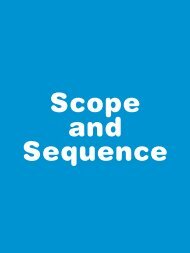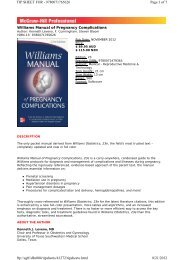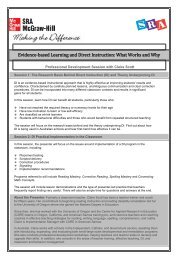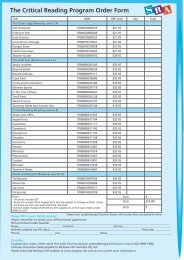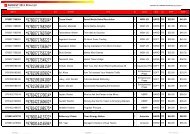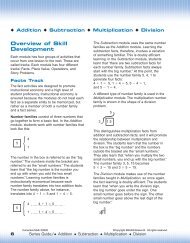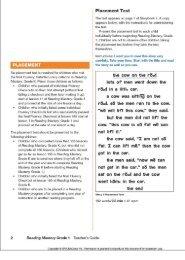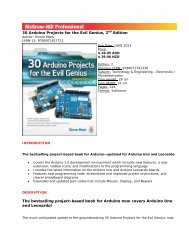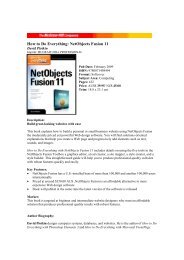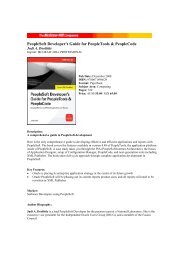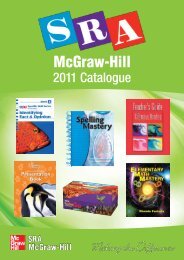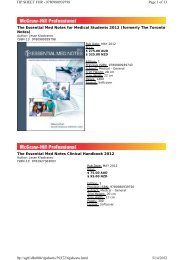Abnormal Laboratory Results - McGraw-Hill Australia
Abnormal Laboratory Results - McGraw-Hill Australia
Abnormal Laboratory Results - McGraw-Hill Australia
Create successful ePaper yourself
Turn your PDF publications into a flip-book with our unique Google optimized e-Paper software.
<strong>Abnormal</strong><br />
<strong>Laboratory</strong><br />
<strong>Results</strong><br />
Manual<br />
QUICK FLICK<br />
Third Edition<br />
Edited by<br />
Geoffrey Kellerman<br />
<strong>Australia</strong>n Prescriber
<strong>Abnormal</strong><br />
<strong>Laboratory</strong> <strong>Results</strong><br />
Edited by Geoffrey Kellerman<br />
<strong>Australia</strong>n Prescriber<br />
Third Edition
Notice<br />
Medicine is an ever-changing science. As new research and clinical experience broaden our<br />
knowledge, changes in treatment and drug therapy are required. The editors and the publisher of<br />
this work have checked with sources believed to be reliable in their efforts to provide information<br />
that is complete and generally in accord with the standards accepted at the time of publication.<br />
However, in view of the possibility of human error or changes in medical sciences, neither the<br />
editors, nor the publisher, nor any other party who has been involved in the preparation or<br />
publication of this work warrants that the information contained herein is in every respect accurate<br />
or complete. Readers are encouraged to confirm the information contained herein with other<br />
sources. For example, and in particular, readers are advised to check the product information sheet<br />
included in the package of each drug they plan to administer to be certain that the information<br />
contained in this book is accurate and that changes have not been made in the recommended dose<br />
or in the contraindications for administration. This recommendation is of particular importance in<br />
connection with new or infrequently used drugs.<br />
This third edition published 2011<br />
First edition published 2001<br />
Second edition published 2006<br />
Text © 2011 Commonwealth Government of <strong>Australia</strong> and National Prescribing Service<br />
Illustrations and design © 2011 <strong>McGraw</strong>-<strong>Hill</strong> <strong>Australia</strong> Pty Limited<br />
Additional owners of copyright are acknowledged on the Acknowledgments page<br />
Every effort has been made to trace and acknowledge copyrighted material. The authors and<br />
publishers tender their apologies should any infringement have occurred.<br />
Reproduction and communication for educational purposes<br />
The <strong>Australia</strong>n Copyright Act 1968 (the Act) allows a maximum of one chapter or 10% of the pages<br />
of this work, whichever is the greater, to be reproduced and/or communicated by any educational<br />
institution for its educational purposes provided that the institution (or the body that administers<br />
it) has sent a Statutory Educational notice to Copyright Agency Limited (CAL) and been granted<br />
a licence. For details of statutory educational and other copyright licences contact: Copyright<br />
Agency Limited, Level 15, 233 Castlereagh Street, Sydney NSW 2000. Telephone: (02) 9394 7600.<br />
Website: www.copyright.com.au<br />
Reproduction and communication for other purposes<br />
Apart from any fair dealing for the purposes of study, research, criticism or review, as permitted<br />
under the Act, no part of this publication may be reproduced, distributed or transmitted in any<br />
form or by any means, or stored in a database or retrieval system, without the written permission<br />
of <strong>McGraw</strong>-<strong>Hill</strong> <strong>Australia</strong> including, but not limited to, any network or other electronic storage.<br />
Enquiries should be made to the publisher via www.mcgraw-hill.com.au or marked for the attention<br />
of the permissions editor at the address below.<br />
National Library of <strong>Australia</strong> Cataloguing-in-Publication Data<br />
Title: <strong>Abnormal</strong> laboratory results / edited by Geoffrey Kellerman.<br />
Edition: 3rd ed.<br />
ISBN: 9780070998421 (pbk.)<br />
Notes: Includes index.<br />
Subjects: Diagnostic errors.<br />
Diagnosis, <strong>Laboratory</strong>—Evaluation.<br />
Clinical chemistry.<br />
Other Authors/Contributors: Kellerman, Geoffrey.<br />
Dewey Number: 616.0756<br />
Published in <strong>Australia</strong> by<br />
<strong>McGraw</strong>-<strong>Hill</strong> <strong>Australia</strong> Pty Ltd<br />
Level 2, 82 Waterloo Road, North Ryde NSW 2113<br />
Associate editor: Fiona Richardson<br />
Art director: Astred Hicks<br />
Internal design: Peta Nugent<br />
Production editor: Claire Linsdell<br />
Copyeditor: Kathy Kramer<br />
Illustrator: Alan Laver, Shelly Communications<br />
Proofreader: Vicki Deakin<br />
Indexer: Barbara Bessant<br />
Typeset in Zapf Humanist 8/10.5pt by Midland Typesetters, <strong>Australia</strong><br />
Printed in China on 80gsm matt art by IBook Printing Limited
Foreword<br />
A bewildering array of laboratory tests is available to today’s health<br />
professionals, and there is more to these tests than ticking a box on a request<br />
form and looking at the normal range of results. To provide more detail about<br />
commonly ordered tests, <strong>Australia</strong>n Prescriber runs a series called ‘<strong>Abnormal</strong><br />
<strong>Laboratory</strong> <strong>Results</strong>’. Although this may seem an odd topic for a journal mainly<br />
concerned with drugs, laboratory tests have an important role in therapeutics.<br />
<strong>Australia</strong>n Prescriber first published a booklet on laboratory tests in 1987.<br />
Over the ensuing years more articles appeared in the series, so there was<br />
a need to update the booklet. Compiling and revising all the material was<br />
beyond the resources of <strong>Australia</strong>n Prescriber but <strong>McGraw</strong>-<strong>Hill</strong> was able to<br />
help and gave Dr Robert Dunstan the responsibility of updating all of the<br />
articles published since 1978. The result was the first edition of <strong>Abnormal</strong><br />
<strong>Laboratory</strong> <strong>Results</strong>, which appeared in 2001.<br />
By 2006, <strong>Australia</strong>n Prescriber had published enough articles on new<br />
topics to warrant a second edition of the book. This was edited by Professor<br />
Geoffrey Kellerman, who not only added the new chapters but also ensured<br />
that the earlier chapters were brought up to date.<br />
<strong>Australia</strong>n Prescriber has published more articles in the <strong>Abnormal</strong><br />
<strong>Laboratory</strong> <strong>Results</strong> series over the past four years. I am pleased that Professor<br />
Kellerman has again agreed to prepare these articles for the third edition of<br />
the book.<br />
This 2011 edition is timely because NPS, the publisher of <strong>Australia</strong>n<br />
Prescriber, has recently established a Quality Diagnostic Referrals program.<br />
This has the aim of improving the use of laboratory tests. <strong>Abnormal</strong><br />
<strong>Laboratory</strong> <strong>Results</strong> will be a perfect complement to these educational<br />
activities.<br />
Dr John S. Dowden<br />
Editor, <strong>Australia</strong>n Prescriber<br />
Canberra<br />
www.australianprescriber.com<br />
<strong>Australia</strong>n Prescriber is published by NPS, an independent, not-for-profit organisation<br />
funded by the <strong>Australia</strong>n Government Department of Health and Ageing.
Contents<br />
Foreword<br />
Preface to the third edition<br />
Contributors<br />
Acknowledgments<br />
iii<br />
vii<br />
viii<br />
xviii<br />
Part 1 General Issues 1<br />
1 What to do about abnormal laboratory results 2<br />
2 <strong>Abnormal</strong> laboratory results 6<br />
3 What does the reference range of a biochemical<br />
screen test mean? 10<br />
4 Pitfalls in interpreting laboratory results 14<br />
5 Moving beyond sensitivity and specificity:<br />
using likelihood ratios to help interpret diagnostic tests 23<br />
6 Point-of-care testing comes of age in <strong>Australia</strong> 30<br />
7 Urine testing 40<br />
Part 2 Biochemistry Tests 47<br />
8 Plasma sodium 48<br />
9 Serum potassium 56<br />
10 Serum urea 60<br />
11 Assessing renal function 65<br />
12 Interpreting arterial blood gases 78<br />
13 Calcium and vitamin D 90<br />
14 Magnesium: the forgotten electrolyte 102<br />
15 Hyperuricaemia 111<br />
16 Liver function tests 115<br />
17 Interpretation and significance of a high<br />
blood cholesterol 121<br />
18 Managing hyperlipidaemia: criteria for<br />
investigating lipids 127
19 New cardiac markers 136<br />
20 B-type natriuretic peptide: a new diagnostic tool<br />
for congestive heart failure 142<br />
21 Thyroid function tests 147<br />
22 Evaluating adrenocortical function in adults 155<br />
23 The glucose tolerance test 165<br />
24 Diabetes monitoring: use of glycated haemoglobin<br />
and glycated protein assays 172<br />
25 Fertility testing 179<br />
26 Biochemical tests in pregnancy 184<br />
27 Biochemical tests for abnormalities in pregnancy 192<br />
28 Interpreting paediatric biochemistry results 200<br />
29 Drug screens 207<br />
30 Therapeutic drug monitoring: which drugs,<br />
why, when and how to do it 213<br />
Part 3 Haematology Tests 219<br />
31 The red cells 220<br />
32 Interpreting biochemical tests for iron deficiency:<br />
diagnostic difficulties imposed by the limitations<br />
of individual tests 225<br />
33 Appropriate use of tests for folate and vitamin B 12<br />
deficiency 231<br />
34 Screening for thalassaemia and haemoglobin variants 238<br />
35 Investigations for thrombotic tendencies 247<br />
36 Tests of haemostasis: detecting the patient at risk<br />
of bleeding 256<br />
37 <strong>Abnormal</strong> haematology results in children 264
Contents<br />
Part 4 Microbiology Tests 269<br />
38 Hepatitis B: laboratory diagnosis and vaccination 270<br />
39 Hepatitis C: laboratory diagnosis and monitoring 281<br />
40 HIV testing in <strong>Australia</strong> 293<br />
41 Testing for sexually transmitted infections 301<br />
42 Testing for Helicobacter pylori 314<br />
Part 5 Immunology Tests 319<br />
43 Screening for multiple myeloma 320<br />
44 Testing cell-mediated immunity 327<br />
45 Cell markers 335<br />
46 Skin prick testing and in vitro assays for allergic<br />
sensitivity 340<br />
47 Antinuclear antibodies (ANA) 345<br />
48 Rheumatoid factor and anti-citrullinated peptide<br />
antibody 350<br />
Part 6 Genetic Tests 355<br />
49 BRCA testing for familial breast cancer 356<br />
Index 362
Preface to the<br />
third edition<br />
Since the publication of the second edition of this work in 2006 there have<br />
been 13 further articles in <strong>Australia</strong>n Prescriber in the ‘<strong>Abnormal</strong> <strong>Laboratory</strong><br />
<strong>Results</strong>’ series. These articles, and the 39 from the second edition of<br />
<strong>McGraw</strong>-<strong>Hill</strong>’s <strong>Abnormal</strong> <strong>Laboratory</strong> <strong>Results</strong>, have been collected in this<br />
new edition, and almost every one has been updated. These updates have<br />
been made by the original author, or authors, with the exception of the few,<br />
identified at the beginning of the chapter, where the original author was<br />
unable to perform the task and another expert did so.<br />
In most articles the changes are still relatively minor, so that the book<br />
can maintain its role as a reissue of articles originally published in <strong>Australia</strong>n<br />
Prescriber. However, research gradually adds to or changes accepted<br />
knowledge and practice and this is especially noticeable in the areas<br />
of hyperlipidaemia, calcium and bone metabolism, cardiac troponins,<br />
vitamin B 12<br />
metabolism, rheumatoid arthritis and viral diseases such as<br />
Hepatitis B and C and HIV, where extensive rewriting has occurred.<br />
Chapters from new authors have replaced two of the original articles, and a<br />
single chapter combines the original two on serum creatinine and creatinine<br />
clearance. Most articles include some key references so that interested<br />
readers can extend their study and understanding of areas of special interest.<br />
I am grateful to the authors for their cooperation and to the publishers<br />
for their help and advice during the writing and production periods. It is our<br />
hope that this volume will prove to be of ongoing value to all readers who are<br />
involved, or preparing to become involved, in patient care in any aspect of<br />
the health care system.<br />
While it includes nearly 50 chapters, this book is not yet a complete cover<br />
of all laboratory testing procedures; however, further articles are planned<br />
for <strong>Australia</strong>n Prescriber to cover important aspects that have not yet been<br />
addressed. There is a real lack of a suitable entry-level textbook for students<br />
and new graduates in the area of test ordering and interpretation. This gap<br />
could be filled by a fourth edition of this publication if the requisite articles<br />
can be identified and selected over the next four to five years.<br />
We welcome suggestions from readers for priority areas for future topics.<br />
Geoffrey M. Kellerman
Contributors<br />
T. I. Robertson Chapter 1<br />
Visiting Physician<br />
Westmead Hospital, Sydney, <strong>Australia</strong><br />
J. Fowler Chapter 1<br />
Retired Consulting Physician, Newcastle, <strong>Australia</strong><br />
C. G. Fraser Chapter 2<br />
Retired Clinical Leader<br />
Department of Biochemical Medicine<br />
NHS Tayside, Ninewells Hospital and Medical School,<br />
Dundee, Scotland<br />
G. M. Kellerman Chapter 3<br />
Emeritus Professor of Medical Biochemistry<br />
University of Newcastle<br />
VMO in Clinical Chemistry<br />
Hunter Area Pathology Service, Newcastle, <strong>Australia</strong><br />
P. Phillips Chapter 4<br />
Senior Director<br />
Endocrinology Unit<br />
Queen Elizabeth Hospital, Adelaide, <strong>Australia</strong><br />
J. Attia Chapter 5<br />
Academic Director, General Medicine<br />
John Hunter Hospital, Newcastle, <strong>Australia</strong><br />
M. Shephard Chapter 6<br />
Associate Professor<br />
Director and Senior Research Fellow<br />
Community Point of Care Services<br />
Flinders University Rural Clinical School<br />
Bedford Park, SA, <strong>Australia</strong><br />
J. F. Mahony Chapter 7<br />
Former Renal Physician<br />
Department of Renal Medicine<br />
Royal North Shore Hospital, Sydney, <strong>Australia</strong><br />
T. H. Mathew Chapter 8<br />
Medical Director<br />
Kidney Health <strong>Australia</strong>, Adelaide, <strong>Australia</strong>
G. S. Stokes Chapter 9<br />
Emeritus Professor<br />
Hypertension Unit, Department of Cardiology<br />
Royal North Shore Hospital, Sydney, <strong>Australia</strong><br />
E. P. MacCarthy Chapter 9<br />
Former Head<br />
Hypertension Unit<br />
University of Cincinnati Medical Centre, Cincinnati,<br />
Ohio, United States of America<br />
T. H. Mathew Chapter 10<br />
Medical Director<br />
Kidney Health <strong>Australia</strong>, Adelaide, <strong>Australia</strong><br />
B. J. Nankivell Chapter 11<br />
Department of Renal Medicine<br />
Westmead Hospital and University of Sydney, Sydney, <strong>Australia</strong><br />
A. K. Verma Chapter 12<br />
Resident, General Medicine<br />
Gosford Hospital, Gosford, <strong>Australia</strong><br />
P. Roach Chapter 12<br />
Consultant Physician<br />
Respiratory and Sleep Medicine<br />
Gosford Hospital, Gosford, <strong>Australia</strong><br />
J. D. Wark Chapter 13<br />
Professor of Medicine<br />
University of Melbourne<br />
Head, Bone and Mineral Service<br />
Royal Melbourne Hospital, Melbourne, <strong>Australia</strong><br />
C. J. Yates Chapter 13<br />
Research Fellow<br />
Department of Diabetes and Endocrinology<br />
Royal Melbourne Hospital, Melbourne, <strong>Australia</strong><br />
J. Wu Chapter 14<br />
Registrar, Chemical Pathology<br />
Queensland Health Pathology Service<br />
Brisbane, <strong>Australia</strong>
Contributors<br />
A. Carter Chapter 14<br />
Director Chemical Pathology<br />
Queensland Health Pathology Service<br />
Brisbane, <strong>Australia</strong><br />
B. T. Emmerson Chapter 15<br />
Emeritus Professor<br />
Department of Medicine, University of Queensland<br />
and Honorary Research Consultant<br />
Princess Alexandra Hospital, Woolloongabba, <strong>Australia</strong><br />
L. W. Powell Chapter 16<br />
Director of Clinical Research<br />
Royal Brisbane and Women’s Hospital, Brisbane, <strong>Australia</strong><br />
M. L. Bassett Chapter 16<br />
<strong>Australia</strong>n National University Medical School<br />
Gastroenterology and Hepatology Unit<br />
Canberra Hospital, Canberra, <strong>Australia</strong><br />
W. G. E. Cooksley Chapter 16<br />
Professorial Research Fellow<br />
Discipline of Medicine<br />
University of Queensland, Royal Brisbane and Women’s Hospital<br />
Brisbane, <strong>Australia</strong><br />
A. M. Dart Chapter 17<br />
Professor, Clinical Program Director<br />
Cardiorespiratory/Intensive Care<br />
Alfred Hospital, Melbourne, <strong>Australia</strong><br />
C. M. Reid Chapter 17<br />
Principal Research Fellow and Head<br />
Clinical Informatics and Data Management Unit<br />
School of Public Health and Medicine<br />
Monash University, Melbourne, <strong>Australia</strong>
G. L. Jennings Chapter 17<br />
Professor and Director<br />
Baker IDI Heart and Diabetes Institute<br />
Head, WHO Collaborating Centre for Research and<br />
Training in Cardiovascular Disease<br />
Professor (Honorary)<br />
Faculty of Medicine Nursing & Health Sciences<br />
Monash University, Melbourne, <strong>Australia</strong><br />
R. A. J. Conyers Chapter 17<br />
Professor, Department of Immunology<br />
Monash University, Melbourne, <strong>Australia</strong><br />
E. M. Nicholls Chapter 17<br />
The Alfred Hospital and Baker Medical Research Institute<br />
Melbourne, <strong>Australia</strong><br />
H-G. Schneider Chapter 17<br />
Director of Pathology<br />
Alfred Hospital, Melbourne, <strong>Australia</strong><br />
P. Nestel Chapter 18<br />
Professor, Senior Faculty, Baker IDI Heart and Diabetes Institute<br />
Melbourne, <strong>Australia</strong><br />
P. E. Hickman Chapter 19<br />
Director of Chemical Pathology<br />
ACT Pathology<br />
Associate Professor<br />
<strong>Australia</strong>n National University Medical School<br />
Canberra, <strong>Australia</strong><br />
J. M. Potter Chapter 19<br />
Professor of Pathology<br />
<strong>Australia</strong>n National University Medical School<br />
Executive Director<br />
ACT Pathology<br />
Canberra, <strong>Australia</strong><br />
B. Ewald Chapter 20<br />
General Practitioner and<br />
Senior Lecturer<br />
Centre for Clinical Epidemiology and Biostatistics<br />
University of Newcastle, <strong>Australia</strong>
Contributors<br />
R. H. Mortimer Chapter 21<br />
Department of Endocrinology<br />
Royal Brisbane and Women’s Hospital<br />
Professor, University of Queensland, Brisbane, <strong>Australia</strong><br />
J. T. Ho Chapter 22<br />
Consultant Endocrinologist<br />
Royal Adelaide Hospital, Adelaide, <strong>Australia</strong><br />
D. J. Torpy Chapter 22<br />
Associate Professor<br />
Senior Consultant Endocrinologist<br />
Royal Adelaide Hospital, Adelaide, <strong>Australia</strong><br />
S. K. Gan Chapter 23<br />
Associate Professor in Medicine<br />
Royal Perth Hospital and University of Western <strong>Australia</strong>,<br />
Perth, <strong>Australia</strong><br />
D. J. Chisholm Chapter 23<br />
Emeritus Professor and Head Clinical Diabetes Research<br />
Diabetes and Obesity Research Program, Garvan Institute of<br />
Medical Research and St Vincent’s Hospital, Sydney, <strong>Australia</strong><br />
G. Jones Chapter 24<br />
Head, Department of Chemical Pathology<br />
St Vincent’s Hospital, Sydney, <strong>Australia</strong><br />
D. J. Chisholm Chapter 24<br />
Emeritus Professor and Head Clinical Diabetes Research<br />
Diabetes and Obesity Research Program, Garvan Institute of<br />
Medical Research and St Vincent’s Hospital, Sydney, <strong>Australia</strong><br />
H-G. Schneider Chapter 24<br />
Director of Pathology<br />
Alfred Hospital, Melbourne, <strong>Australia</strong><br />
R. J. Norman Chapter 25<br />
Director, Research Centre for Reproductive Health,<br />
Academic Head, Repromed Pty Ltd<br />
Professor, Department of Obstetrics and Gynaecology<br />
University of Adelaide, Adelaide, <strong>Australia</strong>
H. A. Tran Chapter 26<br />
Head and Associate Professor<br />
Division of Clinical Chemistry, Hunter Area Pathology Service<br />
John Hunter Hospital and University of Newcastle, Newcastle, <strong>Australia</strong><br />
H. A. Tran Chapter 27<br />
Head and Associate Professor<br />
Division of Clinical Chemistry, Hunter Area Pathology Service<br />
John Hunter Hospital and University of Newcastle, Newcastle, <strong>Australia</strong><br />
P. Verras Chapter 28<br />
Complex Biochemistry Department<br />
Division of <strong>Laboratory</strong> Services<br />
Royal Children’s Hospital, Melbourne, <strong>Australia</strong><br />
R. Greaves Chapter 28<br />
Senior Lecturer, Clinical Biochemistry<br />
School of Medical Sciences<br />
Royal Melbourne Institute of Technology<br />
Melbourne, <strong>Australia</strong><br />
N. A. Buckley Chapter 29<br />
Professor of Medicine<br />
University of NSW<br />
Prince of Wales Hospital, Sydney, <strong>Australia</strong><br />
R. A. Ghiculescu Chapter 30<br />
Former Registrar<br />
Department of Clinical Pharmacology<br />
Princess Alexandra Hospital, Brisbane, <strong>Australia</strong><br />
P. Pillans Chapter 30<br />
Professor and Director, Clinical Pharmacology<br />
Princess Alexandra Hospital, Brisbane, <strong>Australia</strong><br />
W. R. Pitney Chapter 31<br />
Late Emeritus Professor<br />
Department of Medicine<br />
University of NSW, Sydney, <strong>Australia</strong><br />
M. Seldon Chapter 31<br />
Senior Haematologist<br />
Hunter Haematology Unit, Mater Hospital and<br />
Hunter New England Area Health Service, Newcastle, <strong>Australia</strong>
Contributors<br />
F. Firkin Chapter 32<br />
Associate Professor of Medicine<br />
Senior Haematologist<br />
St Vincents Hospital<br />
Melbourne, <strong>Australia</strong><br />
B. Rush Chapter 32<br />
Former Director of <strong>Laboratory</strong> Haematology<br />
St Vincent’s Hospital, Melbourne, <strong>Australia</strong><br />
J. Metz Chapter 33<br />
Haematologist<br />
Dorevitch Pathology, Fairfield, <strong>Australia</strong><br />
D. K. Bowden Chapter 34<br />
Associate Professor<br />
Thalassaemia Service, Monash Medical Centre,<br />
Melbourne, <strong>Australia</strong><br />
R. Baker Chapter 35<br />
Professor, Centre for Thrombosis and Haemophilia<br />
Royal Perth Hospital<br />
Murdoch University, Perth, <strong>Australia</strong><br />
J. McPherson Chapter 36<br />
Consultant and Honorary Professor of Medical Education<br />
University of Papua New Guinea<br />
Formerly Consultant Haematologist, Newcastle Mater Hospital,<br />
Newcastle, <strong>Australia</strong><br />
A. Street Chapter 36<br />
Head, Haemostasis and Thrombosis Units<br />
The Alfred Hospital, Melbourne, <strong>Australia</strong><br />
A. L. Greenway Chapter 37<br />
Paediatric Haematologist<br />
Royal Children’s Hospital, Melbourne, <strong>Australia</strong><br />
P. Monagle Chapter 37<br />
Stevenson Professor of Paediatrics<br />
Head Department of Haematology<br />
Royal Children’s Hospital, Melbourne, <strong>Australia</strong>
D. S. Bowden Chapter 38<br />
Head, Molecular Microbiology<br />
Victorian Infectious Diseases Reference <strong>Laboratory</strong><br />
Melbourne, <strong>Australia</strong><br />
S. A. Locarnini Chapter 38<br />
Head, Research and Molecular Development<br />
Victorian Infectious Diseases Reference Library and<br />
Director, WHO Collaborating Centre for Virus Reference<br />
and Research Melbourne, <strong>Australia</strong><br />
S. Nicholson Chapter 38<br />
Victorian Infectious Diseases Reference <strong>Laboratory</strong><br />
Melbourne, <strong>Australia</strong><br />
I. Gust Chapter 38<br />
Professor<br />
Department of Microbiology and Immunology<br />
University of Melbourne, Melbourne, <strong>Australia</strong><br />
D. Siebert Chapter 38<br />
Director of Clinical Virology<br />
Queensland Health Pathology Service<br />
Royal Brisbane Hospital, Brisbane, <strong>Australia</strong><br />
A. J. Thompson Chapter 38<br />
Victorian Infectious Diseases Reference <strong>Laboratory</strong><br />
Melbourne, <strong>Australia</strong><br />
D. S. Bowden Chapter 39<br />
Head, Molecular Microbiology<br />
Victorian Infectious Diseases Reference <strong>Laboratory</strong><br />
Melbourne, <strong>Australia</strong><br />
A. M. Breschkin Chapter 40<br />
Senior Scientist<br />
Victorian Infectious Diseases Reference <strong>Laboratory</strong><br />
Melbourne, <strong>Australia</strong><br />
M. G. Catton Chapter 40<br />
Medical Director and Head<br />
Victorian Infectious Diseases Reference <strong>Laboratory</strong><br />
Melbourne, <strong>Australia</strong>
Contributors<br />
C. J. Birch Chapter 40<br />
Senior Scientist<br />
Victorian HIV Reference <strong>Laboratory</strong>, VIDRL<br />
Melbourne, <strong>Australia</strong><br />
C. Ooi Chapter 41<br />
Director, Sexual Health Service<br />
Conjoint Lecturer<br />
Faculty of Health<br />
University of Newcastle, <strong>Australia</strong><br />
D. Badov Chapter 42<br />
Head of Gastroenterology and Consultant Gastroenterologist<br />
Department of Gastroenterology<br />
Frankston Hospital, Melbourne, <strong>Australia</strong><br />
F. Firkin Chapter 43<br />
Associate Professor of Medicine<br />
Senior Haematologist<br />
St Vincents Hospital, Melbourne, <strong>Australia</strong><br />
S. Limaye Chapter 44<br />
Immunologist<br />
Concord Hospital, Sydney, <strong>Australia</strong><br />
K. Cartwright Chapter 45<br />
Clinical Associate Professor<br />
Senior Consultant Haematologist<br />
Wollongong Hospital, Wollongong, <strong>Australia</strong><br />
R. M. O’Brien Chapter 46<br />
Associate Professor of Medicine, Immunology and Rheumatology<br />
Austin Hospital, Melbourne, <strong>Australia</strong><br />
S. M. Chatfield Chapter 47<br />
Rheumatologist<br />
Royal Melbourne Hospital, Melbourne, <strong>Australia</strong><br />
S. M. Chatfield Chapter 48<br />
Rheumatologist<br />
Royal Melbourne Hospital, Melbourne, <strong>Australia</strong>
C. Lau Chapter 49<br />
Registrar, Genetics and Molecular Pathology<br />
Women’s and Children’s Hospital, Adelaide, <strong>Australia</strong><br />
G. Suthers Chapter 49<br />
Head, Familial Cancer Unit<br />
Women’s and Children’s Hospital, Adelaide, <strong>Australia</strong>
Acknowledgments<br />
The editor would like to thank the following people for their assistance in the<br />
work which led to the production of this book:<br />
• Each chapter’s contributors who, despite their busy schedules, met the<br />
deadlines.<br />
• J. S. Dowden and staff from <strong>Australia</strong>n Prescriber, for their advice and<br />
encouragement.<br />
• Staff from <strong>McGraw</strong>-<strong>Hill</strong> <strong>Australia</strong>, for their cheerful guidance.<br />
• Kathy Kramer, for her copyediting.
Part<br />
General Issues<br />
1
1 What to do about abnormal<br />
laboratory results<br />
The context<br />
A note from the Editor<br />
In the mosaic that represents the totality of the patient’s problem and its<br />
management, laboratory results often play a minor part, sometimes are<br />
moderately important and occasionally are major contributors. These<br />
proportions depend on whether, for example, the patient is in general<br />
practice or a teaching hospital environment. <strong>Laboratory</strong> test results<br />
represent information and information serves to provide material for<br />
thought by the doctor: it is not a substitute for thought. Only in science<br />
fi ction do machine tests make a magic assessment without human<br />
intervention. Dr Robertson (deceased) wrote initially from the point of<br />
view of the physician receiving results of laboratory tests. Dr Fowler<br />
has written recently from the point of view of the physician who is<br />
considering which tests to order. I believe that these two versions of<br />
the same introductory message are both worth reading.<br />
T. I. Robertson<br />
A biochemical profile in a symptomless male patient of 50 years shows<br />
a modestly elevated serum uric acid. Anti-gout medication lowers the<br />
level but causes a generalised skin rash that lasts for 3 months. A patient,<br />
55 years old, in hospital with a myocardial infarct, is found on a routine<br />
blood count to have a haemoglobin level of 110 g/L. The stained film<br />
suggests iron deficiency. Follow up investigation uncovers a symptomless<br />
carcinoma of the caecum, which is successfully removed. These two<br />
examples, each initiated by a routine test, show on the one hand an<br />
annoying disability resulting from treatment that was probably unnecessary<br />
and on the other, a successful conclusion to the pursuit of an apparently<br />
minor abnormality.<br />
We live in a maze of biochemical profiles, screening tests and routine<br />
investigations, a lot of them uncalled for and some presented to us by our
CHAPTER 1: WHAT TO DO ABOUT ABNORMAL LABORATORY RESULTS 3<br />
patients themselves. A new category has been created: the symptomless<br />
patient with an investigational abnormality. These people are at special<br />
risk. Some of them have incipient, developing or subclinical disease and<br />
some have no disease at all. But all will be affected by the medical advice<br />
they receive. Neglect of an apparent triviality may be lethal, yet a clearly<br />
abnormal result may, in the patient’s total interest, be best set aside. The<br />
advent of routine screening procedures has produced fresh problems and<br />
responsibilities and has tended to complicate rather than simplify medical<br />
management.<br />
When should an abnormal result be considered undebatably abnormal?<br />
When should it be acted upon? How vigorously should it be pursued? When<br />
should it be ignored? The magnitude of the problem can be reduced at the<br />
source by discrimination in the investigations requested in the first place.<br />
The fewer tests ordered in isolation—that is, without proper integration<br />
with history, physical examination and general consideration of the clinical<br />
problem—the less difficult will be their interpretation. If a patient requires<br />
investigation of any type, he or she deserves the courtesy of proper history<br />
and examination first.<br />
It is unrealistic to deny the ease, advantages and extra information<br />
provided by the automated blood count and multiple biochemical analysis.<br />
An investigation should, however, be mounted by way of a working diagnosis<br />
to be proved or disproved and the results of all tests viewed in that light.<br />
It should not be an undisciplined fishing expedition. If it is practical for only<br />
selective tests to be requested, to advance the working hypothesis, only<br />
these should be ordered. Secondary tests may be needed after analysis<br />
of the primary ones but this is the preferred approach. The practitioner<br />
advances his or her capabilities by being careful, even parsimonious, with<br />
investigations and by understanding them and their limitations. This applies<br />
to all levels of clinical practice, not least in the teaching hospitals.<br />
Nevertheless the problem of interpreting more or less isolated abnormal<br />
results will always remain. Some of the difficulties in relation to particular<br />
tests are addressed by experts in the chapters that follow.<br />
QUICK FLICK<br />
1<br />
J. Fowler<br />
The clinical assessment, done with diligence, directs the investigations<br />
to support or refute a provisional diagnosis. A poor clinical history and<br />
physical examination (a time consuming process to do properly) does not<br />
permit you to ask the correct questions and poorly directed laboratory<br />
tests will not compensate for the omission. The solution of more difficult<br />
diagnostic dilemmas is dependent on your clinical assessment (that is,<br />
the pretest probability) as modified by the sensitivity and specificity of<br />
test results. When these test results are abnormal but do not support the
4 PART 1: GENERAL ISSUES<br />
provisional diagnosis, they do not of themselves become the problem. The<br />
clinical scenario is reconsidered by a further meticulous history and physical<br />
examination, which will often widen the differential diagnosis, encompassing<br />
the tests already done and perhaps suggesting further tests to enhance the<br />
probability of a diagnosis. The isolated discordant laboratory test(s) will then<br />
be incorporated into the final diagnosis or will need to be considered as a<br />
special pathological problem.<br />
Patients and physicians want immediate answers but many diseases<br />
are subtle and at initial presentation are often incompletely developed.<br />
While there are clinical circumstances which demand immediate action on<br />
incomplete evidence (e.g. suspected bacterial meningitis), it is better where<br />
possible to allow time and observation to assist in solving the problem.<br />
The quick, dogmatic incorrect diagnosis closes off the thinking process.<br />
Honesty requires that we admit difficulty and doubt so that over time careful<br />
observation, with judicious laboratory tests, can give a more accurate final<br />
conclusion than the apparently brilliant guess.<br />
Advances in the accuracy and range of laboratory investigations have<br />
enabled earlier and more exact definition of many clinical problems. Indeed<br />
modern medicine is dominated by X-ray reports, pathological profiles and<br />
tests, followed by more tests. The tests are interpreted by highly trained<br />
specialists, often unfortunately with no available clinical information, so<br />
the clinician should never believe these interpretations unless they can be<br />
integrated into the clinical assessment. Screening tests not linked to symptoms<br />
or a specific hypothesis pose a special problem. How can the clinician<br />
interpret and integrate such abnormal results? A good history, exploring such<br />
things as genetic predisposition and lifestyle risk factors, will often permit<br />
this integration.<br />
<strong>Laboratory</strong> test results purely as numbers are prone to error. For example,<br />
a ‘fasting glucose’ taken after a fruit juice (not considered as food by many<br />
patients and therefore not reported by them) can give an incorrect diagnosis<br />
of diabetes mellitus. A urine sample to assess an albumin leak will give a<br />
spuriously high result if collected after heavy exercise or during menstruation.<br />
A normal glycated haemoglobin (HbA1c) does not mean good diabetic<br />
control if the red cell life span is shortened by, for example, haemolytic<br />
anaemia or slow blood loss. The clinician must know the limitations of tests<br />
ordered and the common causes of inaccurate results and must gather<br />
supporting evidence before acting on the result. When there is discordance a<br />
discussion with the laboratory expert can often be beneficial.<br />
Patients commonly present with non-specific tiredness, exhaustion and<br />
lethargy, and the differential diagnosis is wide. A series of tests is ordered<br />
and the thyroid stimulating hormone (TSH) is found to be slightly elevated<br />
at, say, 6 (range 0.4–4). A possible answer is apparent—but no, the test
CHAPTER 1: WHAT TO DO ABOUT ABNORMAL LABORATORY RESULTS 5<br />
result must answer the question and a TSH of 6 does not equate with major<br />
symptoms—so the clinician must think again.<br />
The experts in the following chapters will discuss the range, specificity<br />
and sensitivity of their laboratory tests, which is the other half of the<br />
equation. Read on and enjoy the challenges.<br />
QUICK FLICK<br />
1
4 Pitfalls in interpreting<br />
laboratory results<br />
P. Phillips<br />
Synopsis<br />
The results of laboratory tests are affected by the collection and<br />
handling of the specimen, the particular laboratory and the method<br />
of analysis. They are also affected by variability within the individual<br />
and within the laboratory. Interpretation at one point in time should<br />
consider the position of the measurement within the laboratory<br />
reference range appropriate for the sample and the person being tested.<br />
Interpreting results over time should consider the likely variability of<br />
the measurement and the level of certainty required to identify a true<br />
change or absence of change. The more variable the measurement and<br />
the higher the required level of certainty, the larger the change between<br />
measurements needs to be before it can be considered clinically<br />
significant.<br />
Introduction<br />
Health professionals may find it hard to get clinically useful information from<br />
the barrage of figures, ranges, asterisks and comments in laboratory results.<br />
Some knowledge about the accuracy of laboratory results can help to sort<br />
out important clinical signals from the background noise. The laboratory<br />
does not know all the patient’s details. Clinicians should consider test results<br />
in the context of the clinical presentation and not rely completely on the<br />
laboratory’s interpretation.<br />
Reference ranges<br />
Quoted reference ranges depend on the method used in the laboratory and<br />
the population from which the reference range was derived. The results<br />
from one method may be systematically different from those of another<br />
and therefore the reference ranges will be different.
CHAPTER 4: PITFALLS IN INTERPRETING LABORATORY RESULTS 15<br />
Some laboratories give the range quoted by the manufacturer of the test<br />
or derived from an easily accessible population such as blood donors. Others<br />
give ranges in terms of age, sex or biological phase. For example, the ranges<br />
quoted for female sex hormones are related to pre- and post-menopausal<br />
status and the phase of the menstrual cycle. Some important biological<br />
influences, such as seasonal effects on 25-hydroxyvitamin D, are often not<br />
included in the reference ranges. Perhaps this is because users would find it<br />
harder to interpret results if the reference ranges were changing all the time<br />
and because of the logistics and laboratory workload needed to derive such<br />
specific reference ranges.<br />
The ideal reference range would relate to the individual being tested<br />
while healthy, at the same age and in the same biological phase and season.<br />
Clearly this is not possible but sometimes one gets insights from looking back<br />
through previous results (ideally reported by the same laboratory using the<br />
same method).<br />
By tradition, laboratories quote a reference range that includes 95%<br />
of the reference population. If the results are normally distributed, this<br />
includes results within approximately two standard deviations above<br />
and two standard deviations below the mean value. The reference range<br />
therefore covers four standard deviations. Some results vary so much within<br />
the population that the laboratory may quote a reference range that includes<br />
a smaller proportion of the population. For example, the reference range<br />
commonly quoted for serum insulin may include only results within one<br />
standard deviation above and one standard deviation below the mean value.<br />
This covers 68% of the reference population. In this case, 16% of normal<br />
people will have ‘abnormal’ high insulin and 16% will have ‘abnormal’ low<br />
insulin according to the quoted reference range. Serum insulin is therefore<br />
not a useful test for assessing ‘insulin resistance’.<br />
<strong>Results</strong> have to be interpreted in terms of the particular laboratory’s<br />
reference range. When monitoring results over time, clinicians also need to<br />
be aware that different laboratories will have different reference ranges.<br />
As reference ranges are population based, a patient might have a result<br />
near the top or bottom of the normal range. Clinically significant changes<br />
could then occur without the results moving out of the population reference<br />
range. For example, if an elderly patient’s plasma creatinine concentration<br />
is usually near the bottom of the reference range but then rises to the upper<br />
end of that range, the patient may have had a significant deterioration in<br />
renal function. Similar considerations apply to a haemoglobin concentration<br />
falling from a high normal to a low normal value.<br />
QUICK FLICK<br />
4
16 PART 1: GENERAL ISSUES<br />
Specimen collection and handling<br />
<strong>Laboratory</strong> results can be affected by the procedures for specimen collection<br />
and handling (Table 4.1). 1 If a result is a surprise, check the patient’s name<br />
and date of birth on the result report. You can also contact the laboratory and<br />
ask if the specimen looked normal and consider repeating the test.<br />
Table 4.1 <strong>Abnormal</strong> laboratory results caused by incorrect collection and<br />
handling †<br />
Step Mechanism Result<br />
Measurement<br />
affected<br />
Sample Incorrect sample Incorrect results For example,<br />
random spot urine<br />
calcium:creatinine<br />
ratio instead of first<br />
voided<br />
Venepuncture<br />
Prolonged<br />
venostasis<br />
Plasma filtration<br />
and concentration<br />
Protein<br />
concentrations—<br />
globulins, albumins<br />
and lipoproteins<br />
and measurements<br />
affected by them<br />
(e.g. calcium)<br />
Difficult<br />
venepuncture<br />
Haemolysis<br />
Red cell leakage<br />
with high potassium,<br />
phosphate<br />
and lactate<br />
dehydrogenase<br />
Specimen tube<br />
Incorrect collection<br />
tube<br />
Assay affected<br />
• If potassium<br />
EDTA used<br />
for chemistry—<br />
potassium;<br />
calcium and<br />
enzymes<br />
(calcium binding<br />
and enzyme<br />
inhibition)<br />
• Lithium heparin<br />
anticoagulant—<br />
lithium assay
CHAPTER 4: PITFALLS IN INTERPRETING LABORATORY RESULTS 17<br />
Step Mechanism Result<br />
Specimen handling Delay in transport Red cell use<br />
of glucose and<br />
leakage of contents<br />
Measurement<br />
affected<br />
Blood glucose<br />
(if fluoride tube not<br />
used)<br />
Potassium,<br />
bicarbonate,<br />
phosphate, lactate<br />
dehydrogenase<br />
Specimen<br />
mislabelling<br />
Incorrect results<br />
Virtually everything<br />
<strong>Laboratory</strong><br />
Machine<br />
malfunction<br />
Transcription error<br />
Incorrect results<br />
Virtually everything<br />
†Derived from reference 1<br />
Why normal people often have abnormal results<br />
A multiple biochemical analysis can be performed by one machine and<br />
produce 20 results. Assuming these results were all independent of each<br />
other (which they are not) and that results from the reference population are<br />
normally distributed (which they may not be), only 36% of normal people<br />
will have all 20 results in the reference range and 64% will have at least one<br />
abnormal result (Table 4.2). However, the more abnormal the result and the<br />
more related tests are abnormal, the more likely the abnormality is clinically<br />
significant.<br />
QUICK FLICK<br />
4<br />
Table 4.2 Normal results in normal people<br />
If the reference range covers 95% of results for a normal population, the chance of a<br />
healthy individual having a certain number of normal tests is:<br />
• Two out of two tests: 0.95 0.95 = 90%<br />
20<br />
• All 20 of 20 tests: 0.95 = 36%<br />
If you consider the 99% reference range (approximately ± 2.6 standard<br />
deviations) and the 99.9% reference range (approximately ± 3.3 standard<br />
deviations), 82% and 98% of people will have all 20 tests within the<br />
reference range (0.99 20 and 0.999 20 , respectively). These facts can be useful<br />
when interpreting an isolated abnormal result.<br />
For example, the reference range of alkaline phosphatase is 30–110 U/L.<br />
This covers two standard deviations below the mean and two above the<br />
mean. One standard deviation is therefore 20 U/L [(110 − 30) ÷ 4]. A result<br />
of 150 U/L is two standard deviations above the upper limit of the reference
18 PART 1: GENERAL ISSUES<br />
range and therefore four standard deviations above the mean. This is very<br />
unlikely to occur in a normal individual. However, the result may be normal<br />
if the quoted reference range is inappropriate. For example, in pregnancy<br />
and growing children alkaline phosphatase is produced by the placenta and<br />
bone. These are good examples of why it is important to consider whether<br />
the population reference range is appropriate for the individual being tested.<br />
When deciding if a result is abnormal, look at related tests. Alkaline<br />
phosphatase is one of the liver function tests (others are bilirubin, gamma<br />
glutamyl transferase, alanine aminotransferase, aspartate aminotransferase<br />
and lactate dehydrogenase). <strong>Abnormal</strong>ities in the other tests would suggest<br />
that the abnormal alkaline phosphatase could be the result of liver disease.<br />
An elevated alkaline phosphatase in isolation may indicate another problem,<br />
such as bone disease.<br />
<strong>Laboratory</strong> accuracy<br />
We often know the within-laboratory, within-method variability as this is<br />
usually quoted by the laboratory. Modern laboratories provide remarkably<br />
consistent results for many analytes—typical coefficients of variation (see<br />
Table 4.3) are 1–6% for the components of multiple biochemical analysis,<br />
electrolytes, calcium and phosphorus and renal and liver function tests.<br />
Table 4.3 Coeffi cient of variation<br />
The coefficient of variation (CV) is calculated as:<br />
CV = standard deviation of the measured value ÷ mean value of the measurements<br />
100<br />
Variability is different at different absolute values of the measurement and is usually<br />
quoted at a specific clinically relevant value. For example:<br />
CV for plasma sodium: 0.8% at 139 mmol/L<br />
CV for plasma bilirubin: 6.1% at 10 micromol/L<br />
The coefficient of variation is one way of expressing the variability of biological<br />
measurements. Laboratories sometimes also refer to the imprecision of a<br />
measurement.<br />
National quality control programs monitor the accuracy and imprecision of<br />
different methods used in different laboratories. One result has been that the<br />
differences between laboratories for individual methods are now usually a<br />
small component of the overall variability of measurements.
CHAPTER 4: PITFALLS IN INTERPRETING LABORATORY RESULTS 19<br />
Why values vary within one individual<br />
In addition to the variations caused by specimen collection and handling and<br />
the differences within and between laboratories and their methods, there<br />
is intra-individual variation. Assuming specimen collection and processing<br />
errors do not occur, the largest source of variability is within the individual.<br />
Values vary by age and sex and within the menstrual, diurnal and seasonal<br />
cycles. Intra-individual biological variability for different analytes can range<br />
from very large to moderate, for example, 8% for total cholesterol 2 versus<br />
40% for microalbuminuria assessed by the albumin:creatinine ratio 3 .<br />
In addition, the longer the interval between tests, the greater the total<br />
intra-individual variability of the measure.<br />
It is much more difficult for laboratories to provide information on<br />
the total intra-individual variability than for the within-laboratory, withinmethod<br />
variability, which is automatically generated by their quality control<br />
programs. However, it is the total variability within an individual which is<br />
important when interpreting results.<br />
Are changes in results caused by intra-individual<br />
variability or the effects of treatment?<br />
One trap is the phenomenon of regression to the mean. 4 <strong>Results</strong> within an<br />
apparently homogeneous group of patients are likely to lie within the 95%<br />
reference range for that measurement. If the same patients are re-tested at<br />
a different time, the pattern of the overall results will look much the same.<br />
In a normal distribution, values are bunched around the group mean and<br />
progressively ‘thin out’ further from the mean. However, individual results<br />
are likely to have changed, particularly those at the extremes.<br />
The initial results at the extremes are the result of extreme random<br />
variability in one direction or the other. The same amount and direction<br />
of variability is unlikely to occur on the second measurement in the<br />
same individual. Subsequent measurements will therefore move closer to<br />
the middle (or regress to the mean). <strong>Results</strong> from other individuals who<br />
initially were closer to the mean may now lie closer to the extremes of<br />
the distribution.<br />
This phenomenon can be exploited intentionally or unintentionally in<br />
trials that select and treat individuals with high values of a measurement<br />
to demonstrate that a treatment is effective. Regression to the mean is one<br />
reason why randomised placebo controlled prospective trials are the gold<br />
standard for assessing treatments.<br />
A large difference between two measurements is more likely to be<br />
a signal of a true change than the result of the background noise of<br />
measurement variability. Similarly, the smaller the total intra-individual<br />
QUICK FLICK<br />
4
20 PART 1: GENERAL ISSUES<br />
variability, the more likely a specific absolute change is a signal. The less likely<br />
the observed change is caused by variability, the surer one can be that the<br />
change is real.<br />
These three elements are brought together in the concept of the least<br />
significant change. To be 80% confident the observed change is real, the<br />
change should exceed approximately twice the intra-individual coefficient<br />
of variation (CV i<br />
) (Table 4.4). For example:<br />
• A total cholesterol that decreases from 7.0 to 5.6 mmol/L after starting a<br />
statin is a 20% fall from the initial value. The CV i<br />
for total cholesterol is 8%<br />
so the least significant change is approximately 16% (2CV i<br />
). You can be<br />
80% sure that the 20% change is real rather than apparent.<br />
• A decrease in microalbuminuria from an albumin:creatinine ratio<br />
of 5.0 mg/mmol to 2.0 mg/mmol after starting an angiotensin<br />
converting enzyme (ACE) inhibitor is a 60% fall. The total CV i<br />
of the<br />
albumin:creatinine ratio is 40% so the least significant change is<br />
approximately 80% (2CV i<br />
). It is likely that this 60% change is apparent<br />
rather than real.<br />
Table 4.4 When is a change signifi cant?<br />
Least significant change<br />
1. The overall variability of the difference between two measurements is greater than<br />
the variability of the individual measurements: √2 CV i<br />
.<br />
2. The more confident one wishes to be that the change in a measurement is a signal<br />
rather than noise, the greater the change needs to be relative to this: √2 CV i<br />
z.<br />
The z value is used to refer to normally distributed values and describes the<br />
distance of a particular value from the mean in numbers of standard deviations<br />
(SD). The greater the distance from the mean (the z value) the less likely a<br />
result has occurred by chance. z varies from 1.28 for 80% confidence to 2.6 for<br />
99% confidence.<br />
3. Generally an 80% confidence is used (z = 1.28):<br />
Least significant change = √2 CV i<br />
1.28 = 1.8 CV i<br />
.<br />
This approximates to 2CV i<br />
.<br />
Intra-individual coefficient of variation (CV i<br />
)<br />
For a list of intra-individual CV i<br />
for different analytes, see reference 5.<br />
Variability of the difference between two measurements<br />
CV i1<br />
= intra-individual coefficient of variation for the first measurement<br />
CV i2<br />
= intra-individual coefficient of variation for the second measurement<br />
2<br />
The variability of the difference between two measurements is √CV i1<br />
+ CV i22<br />
.<br />
2 2<br />
If CV i1<br />
= CV i2<br />
(as measuring the same variable), then CV i1<br />
+ CV i2<br />
= 2CV i12<br />
, so the<br />
2 2<br />
variability of difference is √2CV i1<br />
= √2 √CV i1<br />
= √2CV i1<br />
.
CHAPTER 4: PITFALLS IN INTERPRETING LABORATORY RESULTS 21<br />
The effects of treatment on measurements<br />
may be delayed<br />
<strong>Laboratory</strong> results may take a long time to change after starting treatment.<br />
This may reflect pharmacokinetics, biology or a combination of the two.<br />
The half-life of thyroxine in the body is approximately seven days. Testing<br />
after one week will only show half the expected total effect. (This may<br />
sometimes still be useful information.) By six weeks (six half-lives in this case)<br />
98.4% of the effect will have occurred [1 – (½) 6 ].<br />
When starting a thiazolidinedione (glitazone) the full effect on blood<br />
glucose requires a steady state of the drug (pharmacokinetic effect) but<br />
also requires the shift in fat metabolism that in turn causes the reduction in<br />
glucose (biologic effect). Finally, the glycated haemoglobin (HbA1c) reflects<br />
the average blood glucose over the preceding 4–6 weeks because of the<br />
slow turnover of the red cells (biologic and pharmacokinetic effects). 6 The<br />
combination of these factors means that testing after 1 week of treatment<br />
may show little change in the HbA1c and that 2–3 months may be needed<br />
to show the full effect of treatment.<br />
Another glycated protein (albumin, which becomes fructosamine) has a<br />
much faster turnover. It therefore reflects the average glucose over a shorter<br />
period (2–3 weeks).<br />
One can reduce the variability of the measurement change by reducing<br />
the variability of the baseline and final measurements (e.g. using the mean<br />
of two measurements for each). If both initial and final measurements were<br />
repeated the variability of the change would be reduced to CV i<br />
(not √2CV i<br />
).<br />
Using the microalbuminuria example, with two measurements before<br />
and after the intervention, the least significant change would be 51%<br />
(1.28 40%). You could then be 80% sure that the 60% observed change<br />
was real and not apparent.<br />
QUICK FLICK<br />
4<br />
Summary<br />
When interpreting laboratory results it is important to know that the sample<br />
was collected and handled correctly. The appropriate reference range for the<br />
test should be used. Different laboratories may report different results on the<br />
same specimen.<br />
When comparing results over time, use the same laboratory and<br />
method for testing. Consider the variability of results within the individual<br />
and the least significant change, that is, the amount of difference between<br />
measurements that is likely to be a real biological signal instead of resulting<br />
from the noise of biological variability within the individual and within the<br />
end measurement variability of the laboratory. As a rough rule, the least<br />
significant change is twice the intra-individual coefficient of variation (2CV i<br />
).
22 PART 1: GENERAL ISSUES<br />
If an important clinical decision depends on whether a change occurs<br />
with a particular treatment, consider making two (or more) measurements<br />
before and after starting treatment. This reduces the variability and the<br />
possibility of misinterpreting the regression to the mean of an initial high<br />
or low value. Monitoring trends with time involves more measurements<br />
and gives a more reliable indication of change than a single comparison at<br />
two points.<br />
Remember, the more tests you do the more likely you are to get at least<br />
one false positive outside the laboratory reference range. Aim to limit the<br />
number of tests to those that are relevant to the clinical situation rather than<br />
requesting a screening battery.<br />
When assessing the effects of treatment, consider how long the treatment<br />
will take before the therapeutic effect reaches a steady state (e.g. 4–6 halflives<br />
of a drug) and how long the biological response will take before the<br />
measurement you make reaches a steady state. Trying to assess therapeutic<br />
effects before the response to treatment has reached a steady state can<br />
seriously underestimate the therapeutic effect.<br />
References<br />
1. Phillips P. and Beng C. Electrolytes—‘fun with fluids’. Check (Continuous<br />
Home Evaluation of Clinical Knowledge) program of self assessment.<br />
No. 323. South Melbourne: Royal <strong>Australia</strong>n College of General<br />
Practitioners, 1999.<br />
2. Cooper G.R., Myers G.L., Smith S.J. and Schlant R.C. Blood lipid<br />
measurements. Variations and practical utility. JAMA 1992; 267: 1652–60.<br />
3. Phillipou G. and Phillips P.J. Variability of urinary albumin excretion in<br />
patients with microalbuminuria. Diabetes Care 1994; 17: 425–7.<br />
4. Irwig L., Glasziou P., Wilson A. and Macaskill P. Estimating an individual’s<br />
true cholesterol level and response to intervention. JAMA 1991; 266:<br />
1678–85.<br />
5. Desirable specifi cations for total error, imprecision and bias, derived<br />
from intra- and inter-individual biologic variation. Updated 2010 Feb 15,<br />
www.westgard.com/biodatabase1.htm [cited Mar 3, 2010].<br />
6. Phillipov G. and Phillips P.J. Components of total measurement error for<br />
haemoglobin A1c determination. Clin Chem 2001; 47: 1851–3.



